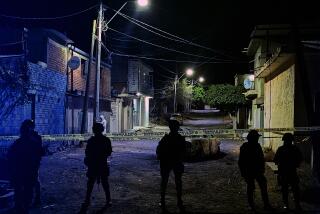Astronomy Helps Optic Perfection
- Share via
When David Williams first looked through the bulky contraption in his laboratory at the University of Rochester, he saw the world as he had never seen it before. His eyesight had become so crisp and so sharp that he could see tiny limbs on trees outside the lab that he didn’t even know were there.
“It reminded me of the first time I put on eyeglasses,” said Williams, a “vision scientist” whose research has led to a much better understanding of how the human eye works. “It’s an experience of crispness, of sharpness, a focus that may not completely knock you off your feet, but it’s a very noticeable improvement.”
The device is based on technology borrowed from the world of astronomy. It is the product of pioneering research that could have a profound impact on everything from eye surgery to contact lenses, and could ultimately improve vision even for people who already have good eyesight.
The university has teamed up with optics giant Bausch & Lomb to develop commercial applications for the technology.
The heart of the system is based on adaptive optics, a technique used by astronomers to remove atmospheric distortion from ground-based telescopes. A computer-driven mirror in the telescope warps ever so slightly to correct distortions caused by atmospheric phenomena, such as moisture or thin clouds that can bend rays of light.
The technique has been so successful in astronomy that images from some ground-based telescopes now rival those from space.
In Williams’ lab, a small mirror, only about 2 inches wide, is driven by 37 tiny computer-controlled pistons that introduce incredibly small deformations--just one-fiftieth the diameter of a human hair--in the surface of the mirror.
At this stage, the device is a bulky contraption designed for basic research, but it is possible to look through it like a telescope. While the viewer is looking through the instrument, the device is looking back into the eye, sorting out imperfections.
A very low-powered laser is flashed onto the retina, reflecting back 217 individual laser beams. A device called a “wavefront sensor” measures deviations in each beam’s path, thus revealing even tiny aberrations in the cornea and lens of the eye.
Traditional eye examinations focus on two aberrations, astigmatism and a problem called “defocus,” the failure of the eye to focus properly. But the Rochester system can measure 65 different aberrations in one-thirtieth of a second.
“The most important aberrations remain defocus and astigmatism,” Williams said. “But all these other aberrations in aggregate actually do produce a substantial amount of image blur,” especially during low-light situations.
The most immediate application for the technology will probably be in refractive surgery. The device can produce images of the inside of a living human eye with such clarity that it could make laser eye surgery much more precise, for example.
Scott MacRae, a pioneer in refractive surgery who has joined the Rochester team, sees the technology as a pathway to something he calls “super vision.”
“In the old days, we were just trying to correct people’s vision problems and treat disease,” MacRae said. “This new research takes what we consider normal vision and enhances it. This is truly revolutionary.”
Williams isn’t ready to go that far, at least not yet. No one is going to be walking around wearing the device in his lab. It covers a large metal table and weighs about a ton.
“It would be really tough on your neck muscles,” he quipped.
But he said the technology could lead to better contact lenses if it can be “refined to sculpt a contact lens in such a way as to correct these higher order aberrations.” Eyeglasses are more of a problem because, as anyone who wears them knows, they don’t always stay in the same place.
Better contact lenses, or some sort of wearable device, could be especially valuable in low-light conditions, because aberrations are most noticeable when the pupil is dilated. MacRae estimates that a driver at dusk could see a bicyclist twice as far away if equipped with adaptive optics correction.
He also sees it as eventually spelling the end to the tiresome process of trying to tell an ophthalmologist which lens is better.
“Someday you may just look into a wavefront sensor such as David has developed, and in one quick second we’ll have all the information needed to improve someone’s vision dramatically,” MacRae said.
Williams expects that people with severe visual problems will probably be among the first beneficiaries.
“People with a lot of aberrations are almost blind,” he said. “If you can develop an optical correction for them with this methodology, you will achieve a huge increase in visual performance. I think that’s very likely, if not certain, to happen.”
The research is funded by the National Science Foundation Center for Adaptive Optics at UC Santa Cruz, the National Eye Institute and Bausch & Lomb.
*
Lee Dye can be reached at leedye@gci.net.
More to Read
Sign up for Essential California
The most important California stories and recommendations in your inbox every morning.
You may occasionally receive promotional content from the Los Angeles Times.






